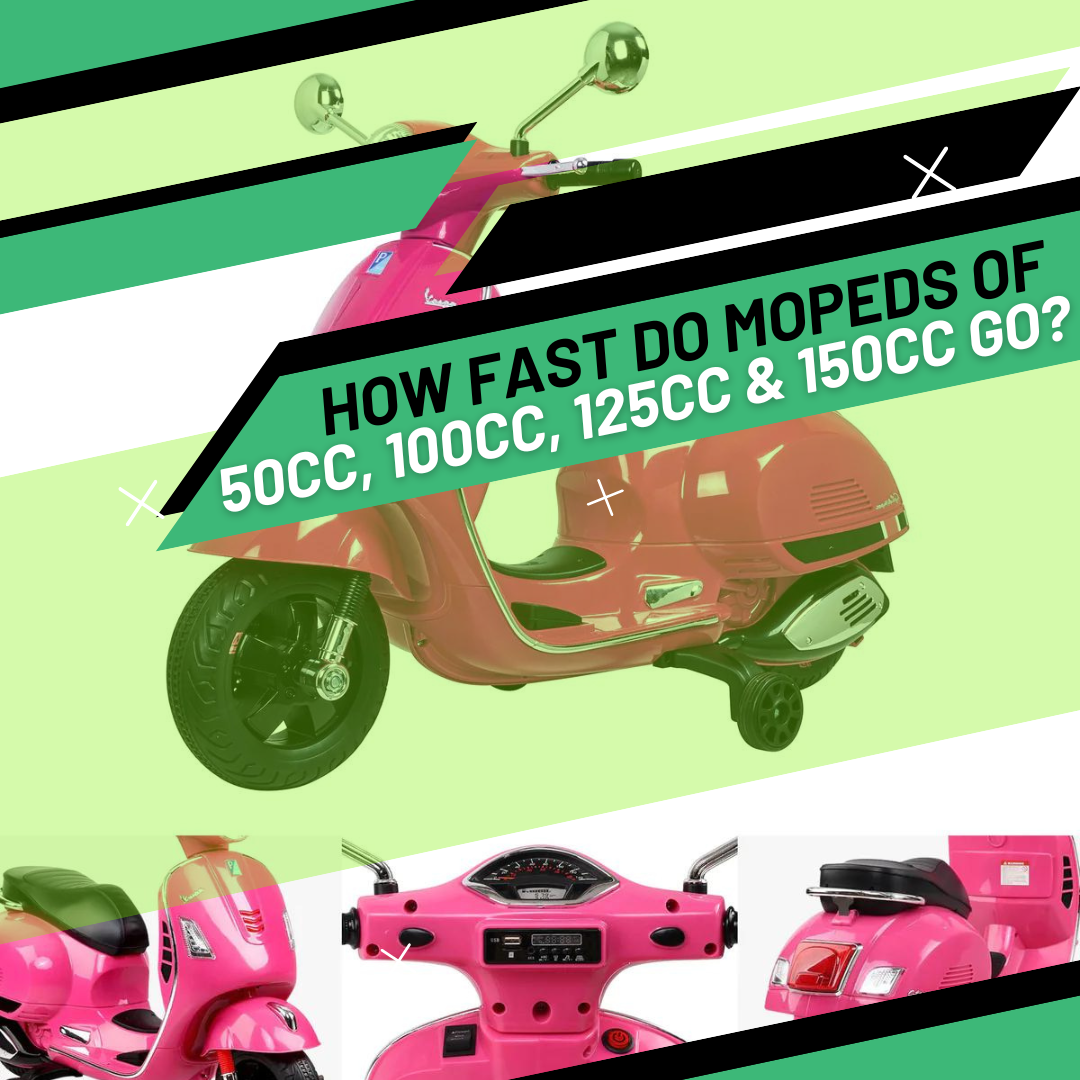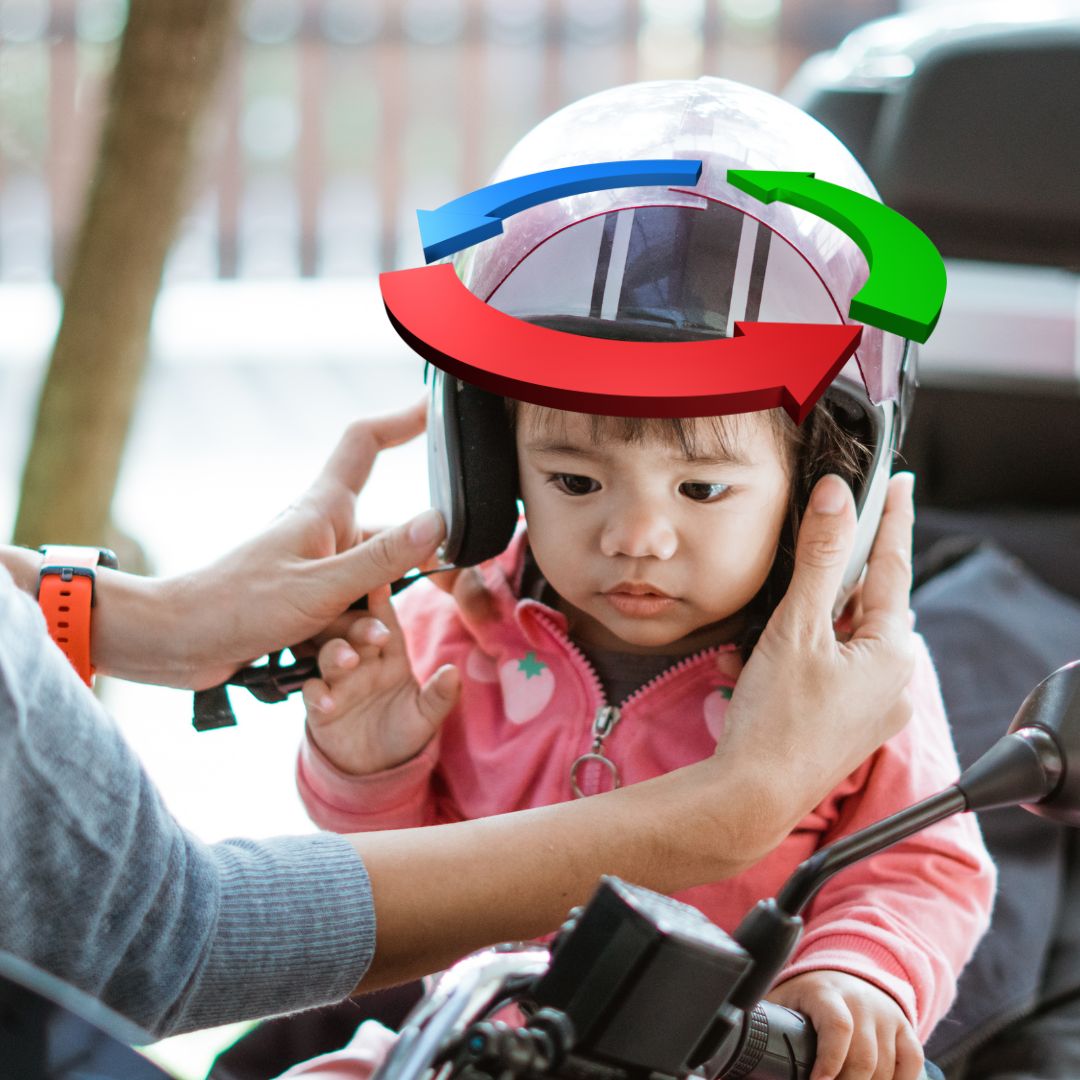How Fast Are Mopeds?
The size of your moped’s engine plays a key role in determining its speed, with capabilities ranging from 30 to 70 mph. For those interested in electric options, models like the Vespa GTS Maxi 12v motorbike offer a great choice for kids.
It’s an impressive range for such a compact vehicle.
To measure engine size, we use a unit called "cubic centimetres"—or "cc" for short. This "cc" value directly influences each moped’s unique top speed.
Let’s explore this further.
Moped Speed Comparison
| Moped Type | Top Speed |
|---|---|
| 50cc | 28–35 mph (depending on restrictions) |
| 100cc | 45–70 mph |
| 125cc | 60 mph |
| 150cc | 70 mph |
| Electric Mopeds | 59 mph |
Understanding Moped Engine Sizes
So, what do these 'cc' numbers signify?
The term 'cc' stands for cubic centimetres and is used to measure the size of the moped's engine, which is directly related to its power output and, hence, speed.
Electric Mopeds: A Modern Alternative
Beyond traditional petrol-powered models, electric mopeds are gaining popularity for their efficiency and eco-friendly design. Unlike their 'cc '-based counterparts, electric mopeds rely on battery power and electric motors, with performance varying by model.
Typical top speeds for electric mopeds range from 30 to 60 mph (48–97 km/h), depending on the motor’s wattage and design. For instance, entry-level models might max out at 30 mph, while high-performance options—like those hitting 59 mph as noted in our comparison table—rival mid-range gas mopeds.
Battery capacity is a key factor, typically ranging from 1 to 4 kWh. A standard electric moped with a 2 kWh battery can offer a range of 40–60 miles (64–97 km) on a single charge, though this varies with rider weight, terrain, and speed. Charging times also differ: a full charge might take 4–8 hours with a standard home outlet or as little as 1–2 hours with a fast charger.
Compared to gas mopeds, electric models stand out for their quieter operation—perfect for noise-sensitive areas—and lower maintenance needs. Without an internal combustion engine, there’s no oil to change or fuel system to clean, though battery health requires attention over time. While upfront costs may be higher, the savings on fuel and upkeep often make them a compelling choice for urban riders.
The Speed of a 50cc Moped
The most basic option, the 50cc moped, typically reaches a maximum speed of 30-35 mph (48-56 km/h), though restricted models may be limited to 28 mph (45 km/h).
This makes it well-suited for inner-city commuting.
Restrictions on 50cc Mopeds
Most 50cc scooters come with a restricted engine, capping their top speed at 28 mph (45 km/h) to comply with licensing laws and enhance rider safety. For comparison, unrestricted models can reach up to 35 mph (56 km/h). If you’re considering a ride for kids, a licensed Vespa 946 12v motorbike offers an exciting alternative.
The Pace of a 100cc Moped
Stepping up, a 100cc moped can achieve a maximum speed of 45-60 mph (72-97 km/h)—ideal for riders seeking a bit more power on their journey.
Speed
45-60 mph
Engine
100cc
Performance
More 'Oomph'
Ideal For
Upgraded Rides
The Speed of a 125cc Moped
Moving further, a 125cc moped ups the game with a top speed of 55-65 mph (88-105 km/h).
Now we're entering the domain of more serious commuting and possibly some light touring.
Speed
55-65 mph
Engine
125cc
Use Case
Serious Commuting
Potential
Light Touring
The Speed of a 150cc Moped
Lastly, the 150cc moped. This one can reach a maximum speed of 65-75 mph (105-121 km/h).
At this speed, you are most certainly not limited to the city anymore.
Speed
65-75 mph
Engine
150cc
Range
Not Limited to City
Capability
Expanded Travel
Factors Affecting Moped Speed
These speeds are, of course, maximums. They may vary depending on factors such as the weight of the rider, terrain, and weather conditions.
Furthermore, it's essential to remember that local laws and regulations regarding the use of mopeds should always be respected.
Factors Affecting Moped Speed
| Factor | Description |
|---|---|
| Rider Weight | Heavier riders may experience lower top speeds. |
| Terrain | Uphill terrain can reduce speed, while downhill can increase it. |
| Weather Conditions | Wind and rain can affect moped speed and handling. |
| Engine Maintenance | Regular maintenance ensures optimal performance and speed. |
AI-Powered Safety Systems
Neuron Mobility has introduced AI-powered cameras on their e-scooter fleet in Melbourne to prevent riders from using footpaths.
The system, called ScootSafe, can identify unlawful behaviour and issue real-time warnings to riders.
This innovative approach not only enhances rider safety but also ensures that pedestrians are protected from potential accidents.
AI technology continuously learns and adapts to various riding patterns, making it more effective over time.
Other manufacturers are likely to follow suit, integrating similar AI-powered safety systems into their moped designs.
Practical Implications of Different Moped Speeds
Each moped speed has its own set of practical applications. If you're looking for a simple ride for short city commutes, a 50cc moped that maxes out at around 30-35mph should be perfect for you.
Need something a bit faster for longer commutes?
A 100cc or 125cc moped might be more up your alley. And for those who are looking at more substantial rides, or even light touring, a 150cc moped could be your best bet.
Choosing the Right Moped for Your Needs
Choosing the right moped is all about understanding your needs and matching them to the right cc size.
Consider your daily commute, the terrain you'll mostly be riding on, and the speed you're comfortable with.
Remember, it's not always about the highest speed but rather the best speed for you.
Safety and comfort should always be your top priorities. After all, isn't the journey supposed to be as enjoyable as the destination?
Licence Requirements and Legal Restrictions in the UK
Here are the licence requirements and legal restrictions for riding motorcycles and mopeds in the UK:
- To ride a moped, learners must be 16 or over, have a provisional moped licence, and complete Compulsory Basic Training (CBT) (123). They can then ride unaccompanied on a public road a two-wheeled vehicle with a maximum design speed of 45 km/h (28 mph), with L plates, for up to two years1.
- To ride a motorcycle up to 125cc with a power output not exceeding 11 kW, learners must satisfactorily complete a CBT course (14). They can then ride unaccompanied on the public road with L plates for up to two years1.
- To ride a standard motorcycle up to 35 kW (and a power-to-weight ratio not more than 0.2 kW per kg), learners must have a provisional Category A driving licence, complete CBT, and pass the theory and practical tests (4). They can then ride unaccompanied on the public road with L plates for up to two years (4).
- To ride an unrestricted motorcycle in size/power, with or without a sidecar, and motor tricycles with power output over 15 kW, learners must have a full Category A driving licence, complete CBT, and pass the theory and practical tests (4). They can then ride unaccompanied on the public road (4).
- Learners who wish to ride a sidecar outfit can do so with a power-to-weight ratio not exceeding 0.16 kW/kg (3).
It's important to note that riders must follow the rules and regulations set out in the Highway Code and other relevant laws.
Additionally, riders must wear appropriate safety gear, such as a helmet, and ensure their vehicle is roadworthy and properly maintained.
Long-term Maintenance Tips and Costs
Maintenance Tips
| Tip | Description |
|---|---|
| Regular Oil Changes | Change the oil every 1000-2000 miles or as recommended by the manufacturer to keep the engine running smoothly. |
| Chain Maintenance | Clean and lubricate the chain every 300-600 miles and adjust chain tension periodically to prevent premature wear. |
| Tyre Care | Check tyre pressure weekly and inspect for wear. Replace tyres when tread depth is less than 1mm. |
| Brake Maintenance | Inspect brake pads regularly and replace when worn. Flush brake fluid every 2 years. |
| Battery Care | Check battery voltage regularly, especially if not ridden frequently. Consider using a battery tender during periods of inactivity. |
| Electrical System Checks | Regularly test lights, turn signals, and horn to ensure proper function. |
Long-Term Costs Breakdown
| Cost Component | Estimated Cost |
|---|---|
| Annual Service | £120-£150 for basic 125cc mopeds |
| MOT | £29.65 (maximum fee set by law for motorcycles/mopeds) |
| Insurance | £325-£1000+ per year, depending on factors like age, driving history, and moped model |
| Fuel | Approximately £560 per year for average usage |
| Road Tax | £25-£123 per year, depending on engine size |
| Oil Changes | Around £30 per change |
| Tyres | £50-£100 per tyre, typically needing replacement every 2-3 years |
| Brake Pads | £20-£40 per set, replaced as needed |
| Gear and Accessories | Initial investment of £200-£500 for helmet, jacket, gloves, etc. Replace as needed. |
Total Estimated Annual Running Costs
- The total estimated annual running costs range from £1,100 to £2,900+, depending on usage, moped model, and individual circumstances. Regular maintenance can help prevent more expensive repairs down the line. Additionally, learning to perform some basic maintenance tasks yourself can significantly reduce long-term costs.
FAQs
What fuel efficiency can I expect from different moped engine sizes?
Fuel efficiency varies based on the engine size, manufacturer, and driving conditions. Generally, smaller engines like 50cc mopeds tend to be more fuel-efficient, often achieving over 100 mpg. Larger engines will generally consume more fuel, but they still offer good fuel efficiency, typically around 80-90 mpg for 125cc and 150cc mopeds.
What is the typical lifespan of a moped engine of different cc?
Moped lifespan is determined by various factors, including maintenance, usage, and build quality. Generally, a well-maintained 50cc moped engine can last between 5,000-10,000 miles. Larger engines like 100cc, 125cc, and 150cc can exceed this, often lasting for over 20,000 miles with proper care.
What is the cost of insuring a moped with different engine sizes?
Insurance costs can vary widely depending on factors such as your age, driving record, and where you live. Typically, insurance for smaller engines like 50cc mopeds is cheaper than for larger 150cc mopeds. Always check with multiple insurance providers to get the best deal.






Share:
How To Start A Quad With A Dead Battery (STEP BY STEP)
How To Tell When Your Quad Needs An Oil Change